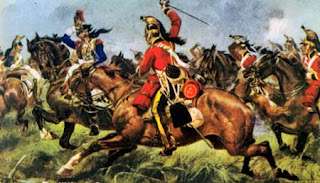Good morning, everyone! It’s always such a delight to be a Risky for a Day.
You might know I’ve started my own blog called “In Search of Heroes,” and I’m having alot of fun with it- the way I look at it, everything related to reading and writing romance is the search for the hero. Today reinforces my theory because today, my hero is a woman, Susanna Dalton Dalbiac, the Heroine of the Battle of Salamanca..
Susanna was born in 1787 and married James Charles Dalbiac, who had joined the 4th Light Dragoons as a cornet in 1797 and made them his lifelong career. Charles joined the Portugal campaign in April 1809, and when he fell ill of a fever, Susanna rushed to his side to nurse him,
and thereafter stayed with him.
According to William Napier, “This gentle lady has followed her husband through two whole campaigns in the Spanish Peninsula. She has been by his side in every danger- in every vicissitude she has borne her loving share. In all the thrilling movements of the past few days she has ridden close to her husband’s regiment. Again and again has he urged her to seek security but as often she has refused to leave him.”
On the night before the Battle of Salamanca, Susanna and her husband slept beneath the stars, she wrapped in his greatcoat, when a thunderstorm struck, stampeding the terrified cavalry horses. Charles snatched up his wife to safety atop some artillery pieces, and he climbed up after her, but there were many of the dragoons who were trampled, Thirty horses were still missing the next morning.
 Despite such an inauspicious start to the day, Wellington found the advantage he needed in the audacious mistake of his counterpart, Marmont, who thought he was seizing an opportunity to outflank the British-Portuguese Army. But he didn’t know Wellington had judiciously hidden Pakenham’s 3rd Division behind the hill, at an angle to the main force, the very place where Marmont’s troops hurried to attack and turn the British flank. As the French over-extended themselves to trap their foe, Pakenham lunged, cutting off a good part of the French forces. Then
Despite such an inauspicious start to the day, Wellington found the advantage he needed in the audacious mistake of his counterpart, Marmont, who thought he was seizing an opportunity to outflank the British-Portuguese Army. But he didn’t know Wellington had judiciously hidden Pakenham’s 3rd Division behind the hill, at an angle to the main force, the very place where Marmont’s troops hurried to attack and turn the British flank. As the French over-extended themselves to trap their foe, Pakenham lunged, cutting off a good part of the French forces. Then
Le Marchant’s Heavy Cavalry came at the enemy in a wild and brutal assault that left the French in ruins and their commander, Thomieres, dead..
The 4th Light Dragoons were a part of Le Marchant’s assault, and Susanna rode after them. As described by Major Elliott, “The cannon shot of the enemy flew past her, the French shells burst all around. Leaden bullets pierced her riding habit in many places.. . The cavalry trumpets rang
out an order, the horses broke into a rapid trot, she drew aside her horse, for she knew that a desperate charge was at that moment to be delivered.”
As the cavalry rode into their own cloud of dust, Susanna spotted a color guard with an arm wound gushing blood, and she bandaged it and gave him wine from her flask. From then on, she raced about from one wounded man to another offering aid, and when her wine was gone, she
bent to a stream to refill her flask, bullets flying all around her and splashing water in her face.
It was many hours later, hunting through the thousands of dead, dying and wounded, not knowing if he lived or had died, before she finally caught up with her husband again, and they embraced on the battlefield. “As the regiment was dismissed from its ranks, all its remaining men gathered around the brave lady with demonstrations of deepest admiration and respect.”
Susanna stayed with her husband until they returned to England, and never returned to the campaign again. In 1814, she gave birth to her daughter, Susanna Stephania Dalbiac, who later married the Scottish Duke of Roxburgh. Many years later, Charles spoke of his wife, “Of this
incomparable wife I will only add that a mind of the most refined cast, and with the frame of body alas too delicate she was, when in the field, a stranger to personal fear.”

 In looking for pictures of Susanna, I could find nothing at all. Then I came upon a family genealogy site which showed a picture of her husband James Charles Dalbiac, in his later years, still in uniform, and one of her daughter. But there’s something wrong with that photo. Most of you can probably spot it quickly. The young woman in the photo- probably a photo of a painting- is wearing a dress of the very late 18th or very early 19th Century, when the elder Susanna would have been a young woman. The younger Susanna was not born when this style was in
In looking for pictures of Susanna, I could find nothing at all. Then I came upon a family genealogy site which showed a picture of her husband James Charles Dalbiac, in his later years, still in uniform, and one of her daughter. But there’s something wrong with that photo. Most of you can probably spot it quickly. The young woman in the photo- probably a photo of a painting- is wearing a dress of the very late 18th or very early 19th Century, when the elder Susanna would have been a young woman. The younger Susanna was not born when this style was in
fashion. So I think the similarity of names fooled someone, and likely the younger Susanna’s husband was better known.
There’s another reason I believe this photo is of Susanna Dalton Dalbiac. When I look at her as a young woman, and at Charles as an older man, there’s just something in their faces. These two were married to each other, don’t you agree?
—
Delle Jacobs
SINS OF THE HEART
ADVENTURE as rich as gold * LOVE as delicious as chocolate
www.dellejacobs.com











